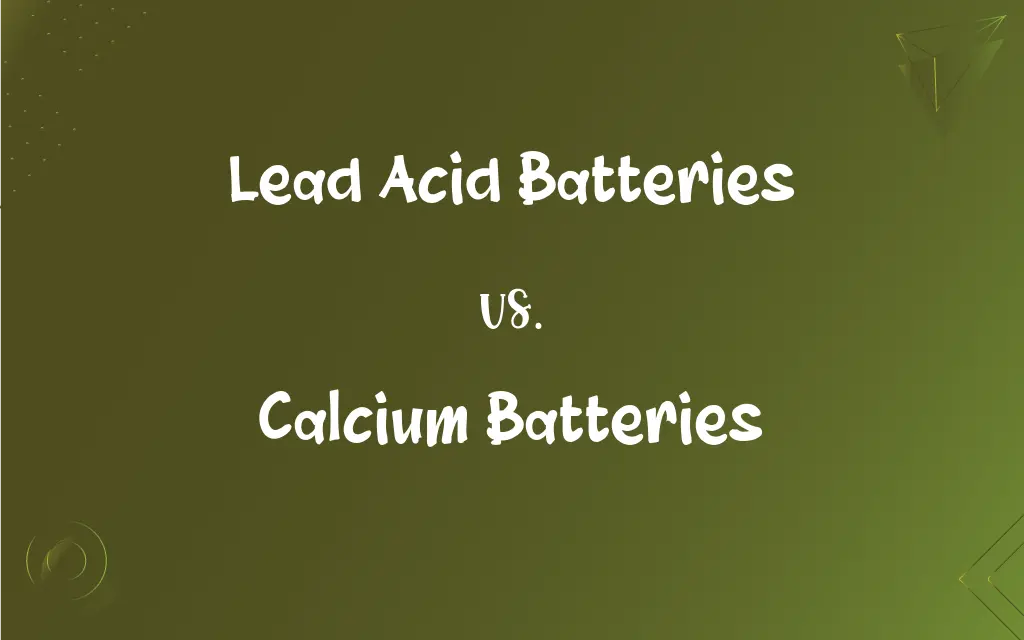Lead Acid Batteries vs. Calcium Batteries: What's the Difference?
Edited by Janet White || By Harlon Moss || Published on January 28, 2024
Lead acid batteries use a lead-dioxide cathode and a sulfuric acid electrolyte, while calcium batteries replace some lead with calcium, enhancing longevity and reducing water loss.

Key Differences
Lead acid batteries are made up of plates of lead and lead dioxide, submerged in a sulfuric acid solution. The chemical reaction between these components produces electricity. In contrast, calcium batteries are a type of lead acid battery where a portion of the lead is replaced with calcium. This alteration results in different chemical properties and behaviors in the battery.
Lead acid batteries, due to their traditional design, often require regular maintenance, including water top-ups to compensate for water loss during electrolysis. Calcium batteries, on the other hand, are designed to reduce water loss. The inclusion of calcium results in a lower rate of self-discharge and water evaporation, thus they are often termed as 'maintenance-free' batteries.
The charge and discharge rates of lead acid batteries are generally reliable, but they are susceptible to degradation if overcharged or deeply discharged frequently. Calcium batteries, with their modified composition, have improved resistance to corrosion and overcharging, which in turn enhances their cycle life and reliability in various applications.
Lead acid batteries are widely known for their cost-effectiveness and high availability. However, they pose environmental concerns due to the lead and acid they contain. Calcium batteries, while slightly more expensive, offer benefits in terms of reduced environmental impact and better performance characteristics, such as lower gassing and reduced water loss.
Lead acid batteries are commonly used in vehicles, backup power systems, and for energy storage in off-grid power systems. Calcium batteries, being more resistant to heat and having a longer shelf life, are often preferred in high-temperature environments and in applications where minimal maintenance is a priority.
ADVERTISEMENT
Comparison Chart
Chemical Composition
Lead, lead dioxide, sulfuric acid
Lead, calcium, lead dioxide, sulfuric acid
Maintenance
Require regular water top-ups
Maintenance-free, less water loss
Durability
Prone to corrosion and water loss
Improved corrosion resistance, longer life
Cost
More cost-effective
Slightly more expensive
Environmental Impact
Higher due to lead and acid
Reduced environmental impact
ADVERTISEMENT
Lead Acid Batteries and Calcium Batteries Definitions
Lead Acid Batteries
A lead acid battery is a rechargeable battery with lead dioxide and lead plates in sulfuric acid.
The car's lead acid battery needed replacing after five years of use.
Calcium Batteries
Calcium batteries are suited for applications where battery maintenance is challenging.
Remote telecom towers often use calcium batteries for their low-maintenance needs.
Lead Acid Batteries
Lead acid batteries are known for their ability to deliver high surge currents despite having a low energy-to-weight ratio.
Lead acid batteries are ideal for starting engines due to their high surge current capability.
Calcium Batteries
Calcium batteries are a type of lead acid battery where calcium is added to the lead plates to improve longevity.
Calcium batteries in solar power systems offer extended life with less maintenance.
Lead Acid Batteries
This type of battery is valued for its cost-effectiveness and large power capacity.
For large-scale energy storage, lead acid batteries offer an affordable solution.
Calcium Batteries
These batteries feature reduced water loss and lower self-discharge rates.
The calcium batteries in our RV lasted longer due to their efficient water retention.
Lead Acid Batteries
Lead acid batteries are widely used in backup power systems for their reliability.
Hospitals rely on lead acid batteries for emergency power during outages.
Calcium Batteries
They offer better resistance to heat and overcharging compared to traditional lead acid batteries.
In the hot desert climate, calcium batteries outperform traditional lead acid batteries.
Lead Acid Batteries
They are the oldest form of rechargeable battery, invented in 1859.
Despite newer technologies, lead acid batteries remain popular due to their proven track record.
Calcium Batteries
Calcium batteries are often used in situations requiring minimal maintenance and reliable power.
Boats equipped with calcium batteries benefit from their maintenance-free nature.
FAQs
What differentiates calcium batteries from lead acid batteries?
Calcium batteries have calcium added to the lead plates for better performance.
What are lead acid batteries?
Traditional rechargeable batteries using lead plates and sulfuric acid.
Can lead acid batteries be used in any weather?
Yes, but extreme temperatures can affect performance and lifespan.
Are calcium batteries environmentally friendly?
More so than traditional lead acid batteries due to reduced lead content and water loss.
Do lead acid batteries require maintenance?
Yes, regular water top-ups and terminal cleaning are necessary.
Can lead acid batteries be recycled?
Yes, they are among the most recyclable battery types.
Are lead acid batteries safe for home use?
Yes, if used and maintained correctly.
How do calcium batteries benefit car owners?
They offer longer life and are maintenance-free, ideal for modern vehicles.
Are calcium batteries good for start-stop vehicle technology?
Yes, they handle frequent starts and stops well.
What is the lifespan of a calcium battery?
Typically longer than standard lead acid batteries, depending on usage.
What's the cost difference between the two?
Calcium batteries are generally more expensive than lead acid batteries.
How do lead acid and calcium batteries handle deep discharges?
Lead acid batteries are less tolerant of deep discharges than calcium batteries.
Can I use calcium batteries in cold climates?
Yes, they perform well in various temperature ranges.
Is it safe to transport lead acid batteries?
With proper safety measures, yes, but they are heavy and contain hazardous materials.
Do calcium batteries produce gas during charging?
Less so than traditional lead acid batteries.
Can lead acid batteries power electric vehicles?
They are not ideal due to weight and lower energy density compared to other battery types.
Do calcium batteries resist overcharging better?
Yes, they have improved overcharge resistance.
Do calcium batteries require special chargers?
No, they can use standard lead acid battery chargers.
Can lead acid batteries be used in solar power systems?
Yes, but calcium batteries might offer better performance and longevity.
How do lead acid batteries impact the environment?
They contain lead and acid, which can be harmful if not properly disposed of.
About Author
Written by
Harlon MossHarlon is a seasoned quality moderator and accomplished content writer for Difference Wiki. An alumnus of the prestigious University of California, he earned his degree in Computer Science. Leveraging his academic background, Harlon brings a meticulous and informed perspective to his work, ensuring content accuracy and excellence.
Edited by
Janet WhiteJanet White has been an esteemed writer and blogger for Difference Wiki. Holding a Master's degree in Science and Medical Journalism from the prestigious Boston University, she has consistently demonstrated her expertise and passion for her field. When she's not immersed in her work, Janet relishes her time exercising, delving into a good book, and cherishing moments with friends and family.
































































